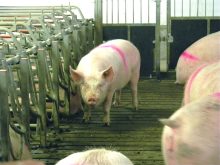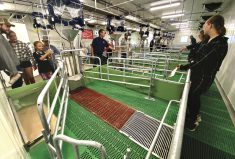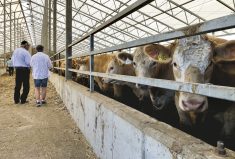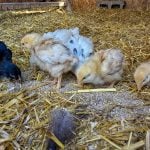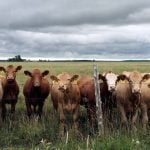A strong farm economy and the demand for new dairy facilities have brought some new building technology to the Ontario market.
Guardian Structures had photos on display at the London Dairy Congress of a newly built dairy barn on the Slegh farm near Salford that featured a different approach to beams.
Guardian Structures worked with the contractor on the project to provide pre-drilled and pre-notched “glulam” – laminates of very thin timber systematically glued to create beams of specific dimensions – for the barn, including 37-inch deep rafter beams running 71 feet from peak to edge of roof.
Read Also

Handling system familiarization lowers animal stress
At Canada’s Outdoor Farm Show, sheep specialist Delma Kennedy stressed familiarization, good facility design, and calm handling to improve flock management.
Spokesman Josh Dewar says eliminating the need to cut and prepare components on site leads to a 30 per cent reduction in construction time for customers choosing glulam.
“Europeans have been (using pre-made, glulam components) for 30-plus years, so it’s not something new,” he said. “But it’s something new to Ontario.”
Referred to by those who produce it as “cross-laminated timber” and “mass timber,” glulam components hold their structure longer than steel or concrete before collapsing in a fire, he said.
During a tour through the company’s manufacturing facility, inside an expansive former auto-parts factory on the southern edge of St. Marys, Dewar explained the precise industry requirements adhered to by Guardian Structures for timber quality. He says that glulam construction has considerable benefits for offsetting greenhouse gas emissions compared to conventional building methods.
The company started in 1996 as Guardian Bridge, making prefabricated components for bridges using glulam covered with fibreglass. They bought additional equipment two years ago to create building components but have been waiting until recently to see mass timber incorporated into the National Building Code of Canada.
Now, under the Guardian Structures name, the company is looking to expand its farm construction side. “We see a good future with the farm industry,” Dewar said.
Jarno Slegh said they decided to use the glulam beams ahead of steel because the the wood beams would be nicer to live with over the life of the barn versus steel.
The Canadian Farm Builders Association says such innovations are welcomed by the industry.
Building design, production methods, efficiency in the processing of plans through to completion must be found if the industry is to be viable for future contractors, according to the CFBA. Accepting new technologies and investing in the training of new skills, and being innovative in the way construction is delivered will separate the winners and losers in the construction industry, organization members told Sally Akroyd Bombino, general manager, of the CFBA in comments she gathered for this article.




